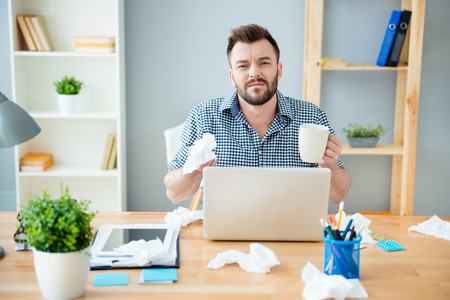Employee wellness is a huge issue and, this time of year, the number of employees calling in sick can be astronomical. In fact, December is the most popular month for employee sick days with January not far behind. Adding to the number of germs in the office, a survey conducted by Wakefield Research found that 62 percent of American workers go to work sick.
So you retreat to your desk, where you’ll be safe, right? Not quite. Here are the top three things at your desk that may be contributing to illness this winter.
Bacteria
A few years ago, a shocking study revealed the average office desk harbors 400 times more bacteria than an average toilet seat. This includes the germs lurking on the keyboard, mouse, phone and the desk surface itself. Other studies confirm similar findings, with one, in particular, finding that men’s offices were up to 20 percent more germ-ridden than women’s.
While not all bacteria is bad for you, the studies found that many—left behind due to not washing hands after visiting the bathroom or not wiping down surfaces before or after eating at the desk—were sickness-causing. And it can happen quite easily. Take these additional statistics: Nearly 50 percent of office workers don’t wash their hands after going to the bathroom, and at least 20 percent don’t clean their desk before or after eating at it. Another 20 percent have never cleaned their computer mouse. Ever.
Eye and neck strain
Take this advice from the folks at CNET: Stop whatever you’re doing and freeze. Now, evaluate your body. Does anything—your neck, perhaps—feel achy? How’s your posture? And your wrists and fingers—are they okay after all that typing and texting?
If so, you could be suffering the effects poor ergonomics. Not only can the way you work at your desk or on your mobile devices contribute to acute problems like eye and neck strain, back problems, numbness in the wrists or fingers and general fatigue, but allowing these problems to persist may lower your ability to fight other illnesses. In addition, OSHA reports work-related musculoskeletal disorders like the ones listed above are among the most frequently reported causes of lost or restricted work time.
Some office workers have started combating this issue with interesting solutions including standing desks, taking frequent breaks and oddly tinted computer glasses. You may want to join them.
Air quality or environment
In 2008, the National Institutes of Health (NIH) published a report identifying a mysterious phenomenon called sick building syndrome (SBS). SBS occurs when the occupants of a building experience acute health- or comfort-related effects that seem to be linked directly to time spent in a particular building. Symptoms can include headache, dizziness, nausea, eye, nose or throat irritation, dry cough, dry or itching skin, difficulty in concentration, fatigue, sensitivity to odors, hoarseness of voice, allergies, cold, flu-like symptoms, increased incidence of asthma attacks and personality changes.
While, at the time, the cause of the symptoms was unknown, it was reported most of the symptoms subsided soon after leaving the building. Since the report was published, some experts speculate SBS is likely caused by inadequate ventilation, chemical contaminants from materials inside the building (like treated wood, paint or carpeting), outdoor pollution entering the building, or biological contaminants like mold or dander.
Protect yourself and improve workplace wellness
What better way to take employee wellness seriously this season than to start at your own desk? First, be sure to wash your hands and clean your desk often. Then, adjust the items around you that may be straining your body. And, finally, take note of the things in the air that may be affecting wellness in the workplace. Do you have additional tips to improve workplace wellness this season? Please share them with us!
Image Copyright: deagreez / 123RF Stock Photo




